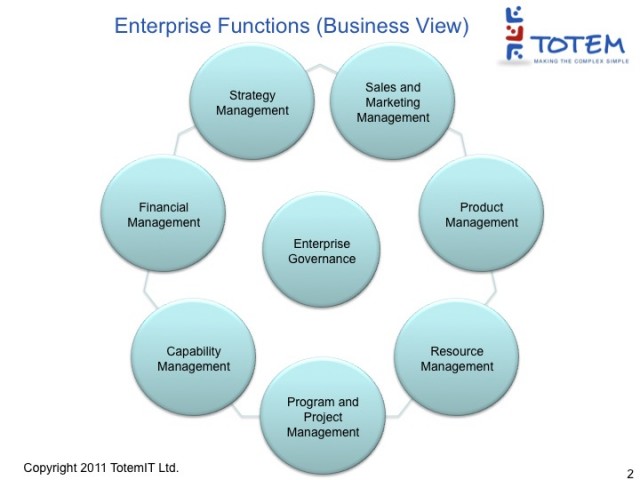TOGAF Phase A: Architecture Vision
The key objectives in this phase are:
- Articulate an architecture vision, i.e. a high level view of business architecture.
- Describe the value proposition of the business architecture.
- Create the high level plan.
1. Articulate the Architecture Vision
At this point it is important to consider the viewpoints of the stakeholders you will need to communicate with and create appropriate artefacts. If the organization does not have formal business architecture a traditional approach may be appropriate.
Business Functions

Figure 2 Enterprise Functions (Business View)
The diagram shows a representation of the very high level functions required by a business. Please note the absence of process, people, and performance etc. that are often included in similar views. This diagram shows “what” an organization does, people, process and other information are part of the “how”, the “why”, “when” and “where” shown in strategy, capability and implementation views.
Function Definitions
Strategy Management: Is responsible for the analysis of performance data, evaluation of options and creation of enterprise strategy.
Sales and Marketing Management: Is responsible for the identification and communication of the enterprises value proposition including services, products and brand etc. and business level selling the product to customers. Retail sales may also be included here, however typically retail sales are performed using automated channels provide by the capability management group based on requirements from sales, marketing and product management.
Product Management: Is responsible for product lifecycle including definition, creation, development, delivery, operation, and removal of products from the market place.
Resource Management: Resources are the physical entities used by the organization; this includes people, technology, buildings etc. Resource management is responsible for the efficient and effective management of all resources during their end to end lifecycle.
(Note: resources are not “sold” to customers. A customer consumes a product that is made up of services. If an item of resource inventory is sold to a customer the enterprise transfers the ownership of the resource to the customer as part of a business transaction)
Project and Program Management: is responsible for creation, co-ordination and delivery of projects and programs.
Capability Management: ensures that the abilities generating business are defined, created, developed, and delivered including day to day processes, and systems, including business continuity etc. It is responsible for the capability
Financial Management is responsible for financial planning, budgeting and reporting etc.
During TOGAF’s next phase, business architecture, the functional decomposition takes place including creating an understanding of the companies environment, market, products and strategic direction.
2. Creating a value proposition
a) Develop the business case for the architectures and changes required
b) Produce the value proposition for each of the stakeholder groupings
A set of qualitative statements of the value of business architecture could start with those listed in the business and IT alignment section.
There are a number of recognised approaches to quantifying the benefits of creating business architecture.
At a high level TOTEM recommends either using an adapted balanced score card and value chains approach originally proposed by Michael Porter. The benefits of system and process re-use can be created and enhanced by product architecture, a product – capability, and system – capability matrix.